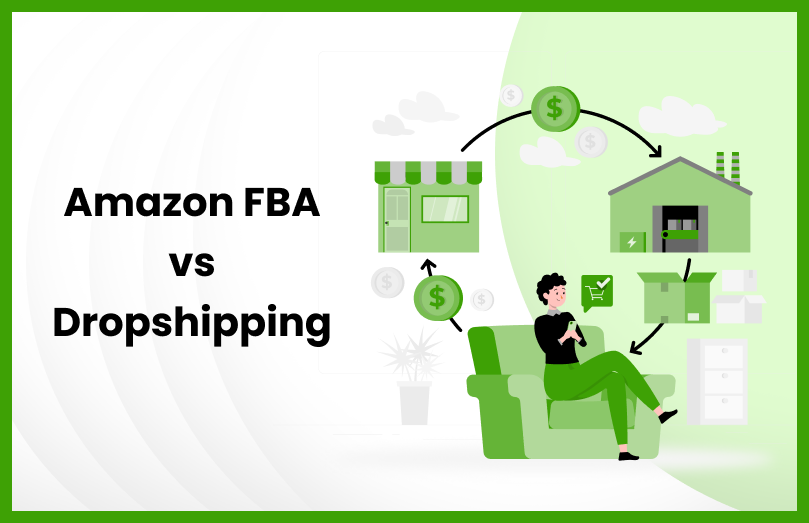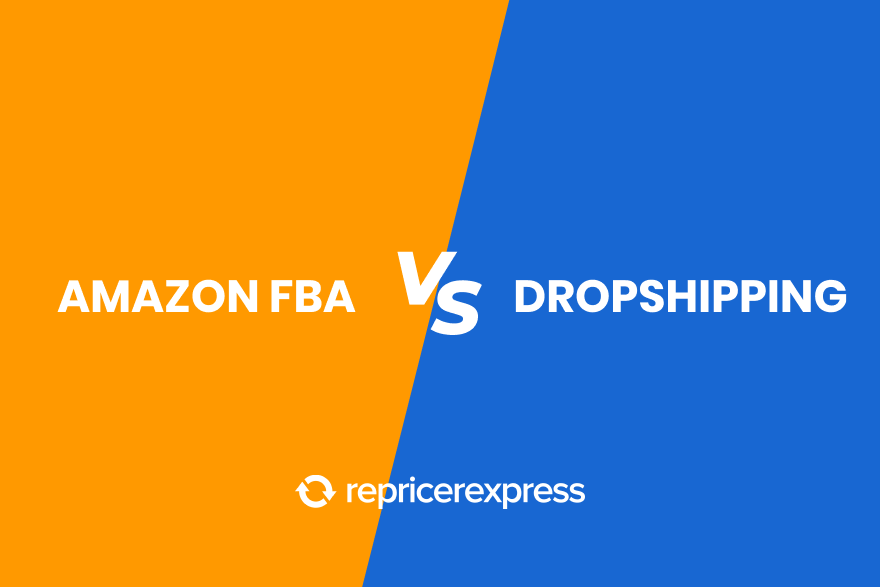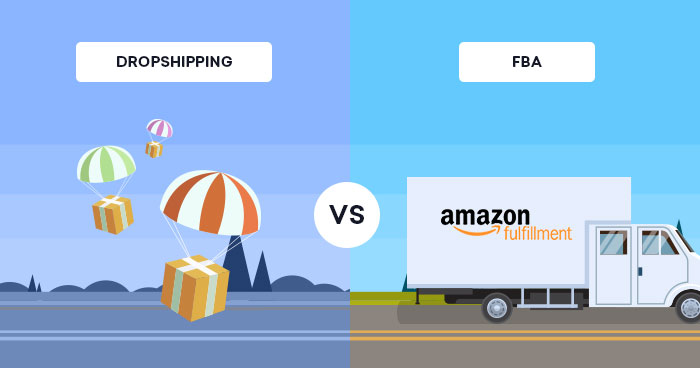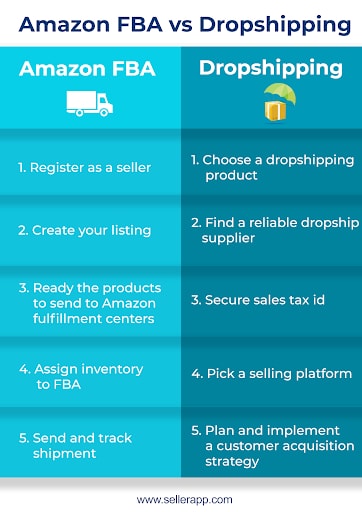Dropshipping requires lower upfront costs and less inventory management. Amazon FBA offers faster shipping and greater scalability.
Dropshipping and Amazon FBA are two popular e-commerce models, each with distinct advantages. Dropshipping allows entrepreneurs to start with minimal investment and avoid inventory hassles. Suppliers ship products directly to customers, reducing overhead. Amazon FBA, on the other hand, involves sending inventory to Amazon’s warehouses, where they handle storage, packing, and shipping.
This model benefits from Amazon’s vast logistics network and Prime eligibility, leading to faster delivery times. Both models have their pros and cons. Dropshipping suits those seeking low-risk entry, while Amazon FBA caters to those aiming for larger scale and efficiency. The best choice depends on your business goals and resources.

Credit: www.mmfinfotech.com
Business Model Comparison
Choosing between Dropshipping and Amazon FBA can be a tough decision. Each model has its own benefits and challenges. This section will compare the two business models to help you decide which is best for your needs.
How Dropshipping Works
Dropshipping is an e-commerce method where the store doesn’t hold inventory. Instead, the store sells products from a supplier. Once a customer orders, the supplier ships the product directly to the customer.
- No Inventory: You don’t need to buy products upfront.
- Low Startup Costs: You only pay for products sold.
- Flexibility: You can add or remove products easily.
In dropshipping, you act as the middleman. Your job is to market and sell the products. The supplier handles storage, packing, and shipping.
| Pros | Cons |
|---|---|
| No upfront inventory costs | Lower profit margins |
| Easy to start | Less control over shipping |
| Flexible product range | High competition |
How Amazon Fba Works
Amazon FBA stands for “Fulfillment by Amazon.” With FBA, you send your products to Amazon’s warehouses. Amazon stores, packs, and ships your products to customers.
- Prime Eligibility: Your products are eligible for Amazon Prime.
- Customer Trust: Customers trust Amazon’s shipping process.
- Less Work: Amazon handles storage, packing, and shipping.
Amazon FBA requires an upfront investment in inventory. You need to buy products in bulk and send them to Amazon. This can be costly but offers faster shipping times.
| Pros | Cons |
|---|---|
| Access to Amazon’s customer base | Upfront inventory costs |
| Prime shipping benefits | Storage fees |
| Less day-to-day management | Strict Amazon policies |
Initial Investment
Determining the initial investment is crucial for choosing between Dropshipping and Amazon FBA. This section will break down the costs associated with both business models. Understanding these expenses will help you decide which option best fits your budget and business goals.
Cost Breakdown For Dropshipping
Dropshipping typically requires a lower initial investment compared to Amazon FBA. Here are the main costs involved:
- Website Hosting: $10 – $30 per month
- Domain Name: $10 – $15 per year
- E-commerce Platform: $29 – $299 per month (Shopify, WooCommerce, etc.)
- Marketing and Advertising: $100 – $500 per month
- Product Research Tools: $20 – $100 per month
In total, the initial costs for starting a dropshipping business can range from $169 to $944 for the first month.
Cost Breakdown For Amazon Fba
Amazon FBA generally requires a higher initial investment. Here are the key costs:
| Cost Type | Amount |
|---|---|
| Amazon Seller Account: | $39.99 per month |
| Product Inventory: | $500 – $2000 (initial stock) |
| Shipping to Amazon Warehouse: | $100 – $500 |
| Product Photography: | $50 – $300 |
| Marketing and PPC: | $100 – $500 per month |
Overall, the initial costs for starting an Amazon FBA business can range from $789.99 to $3339.99 for the first month.
Inventory Management
Understanding inventory management is crucial for any e-commerce business. It can make or break your success. Both Dropshipping and Amazon FBA have unique approaches to managing inventory. Let’s dive into how each model handles it.
Dropshipping Inventory
Dropshipping eliminates the need to maintain physical stock. You don’t buy products upfront. Instead, you list products from suppliers on your store. When customers place an order, your supplier ships directly to them. This means:
- No warehouse costs
- No stock management
- Reduced risk of unsold inventory
Dropshipping allows you to test various products without financial risk. You can focus on marketing and customer service. But, you rely heavily on suppliers. If they run out of stock, it impacts your business.
Amazon Fba Inventory
Amazon FBA (Fulfillment by Amazon) involves sending your products to Amazon’s warehouse. Amazon handles storage, packing, and shipping. Here are the main points:
| Aspect | Benefits | Challenges |
|---|---|---|
| Storage | No need for your own warehouse | Storage fees apply |
| Shipping | Amazon handles shipping | Dependent on Amazon’s logistics |
| Inventory Control | Amazon’s system tracks inventory | Must keep stock levels high |
Amazon FBA offers a professional fulfillment service. It enhances customer trust with quick delivery and returns. But, you need upfront investment in stock. Managing inventory levels is crucial to avoid stockouts or overstocking.

Credit: www.repricerexpress.com
Shipping And Fulfillment
Shipping and fulfillment are critical aspects of any e-commerce business. It impacts customer satisfaction and overall success. Let’s compare the shipping process in Dropshipping and Fulfillment by Amazon (FBA).
Shipping Process In Dropshipping
In Dropshipping, the seller does not hold inventory. Instead, the supplier ships products directly to the customer. This process eliminates the need for storage space and reduces overhead costs. However, it can also lead to longer shipping times. The seller has little control over the shipping process.
- Inventory Management: No need to manage or store inventory.
- Shipping Time: Typically longer as products ship from the supplier.
- Costs: Lower upfront costs but potential higher shipping fees.
- Control: Limited control over the shipping process and delivery times.
Fulfillment By Amazon
Fulfillment by Amazon (FBA) offers a different approach. Sellers send their products to Amazon’s fulfillment centers. Amazon then handles storage, packing, and shipping. This ensures faster delivery times and better customer service. Using FBA can lead to increased sales through Amazon Prime.
| Aspect | Dropshipping | FBA |
|---|---|---|
| Inventory | No inventory management | Amazon stores the inventory |
| Shipping Time | Longer | Faster |
| Costs | Lower upfront | Storage and service fees |
| Control | Limited | More control |
Both shipping methods have their pros and cons. Dropshipping requires less upfront investment. FBA offers better customer service and faster shipping times.
Profit Margins
Understanding profit margins is crucial for any business. It helps determine which model is more profitable. We will compare earnings in dropshipping and Amazon FBA.
Earnings In Dropshipping
In dropshipping, you don’t hold inventory. This reduces upfront costs. You only buy a product after a customer orders it. This lowers risk but also affects profit margins.
Here are some key points:
- Lower initial costs
- Minimal storage fees
- Average profit margins: 10-30%
Here is a table summarizing the potential earnings:
| Revenue | Cost of Goods Sold (COGS) | Gross Profit | Profit Margin |
|---|---|---|---|
| $1000 | $700 | $300 | 30% |
| $500 | $450 | $50 | 10% |
Earnings In Amazon Fba
Amazon FBA involves selling products stored in Amazon’s warehouses. You pay for storage and fulfillment services. This can affect your profit margins.
Key points include:
- Higher initial investment
- Storage and fulfillment fees
- Average profit margins: 15-25%
Here is a table summarizing the potential earnings:
| Revenue | Cost of Goods Sold (COGS) | Fulfillment Fees | Gross Profit | Profit Margin |
|---|---|---|---|---|
| $1000 | $600 | $100 | $300 | 30% |
| $500 | $350 | $50 | $100 | 20% |
Both models offer different profit margins. Your choice depends on your business goals and resources.
Customer Service
Customer service is crucial in e-commerce. It can impact your business reputation. Both dropshipping and Amazon FBA have unique approaches to customer support. Let’s explore how they differ.
Customer Support In Dropshipping
In dropshipping, the supplier handles product shipping. But the seller manages customer service. This setup can be challenging. Sellers often face issues like:
- Long shipping times
- Product quality complaints
- Inventory issues
Sellers must address these concerns. They must communicate with suppliers. They also need to keep customers informed. This can be time-consuming. Poor customer service can lead to negative reviews.
Customer Support In Amazon Fba
Amazon FBA stands for Fulfillment by Amazon. Amazon handles storage, shipping, and customer service. This includes:
- 24/7 customer support
- Returns and refunds management
- Quick shipping with Prime
Amazon’s robust system ensures customer satisfaction. Sellers have less to worry about. They can focus on other aspects of their business. This can lead to better reviews and higher sales.
Scalability
Scalability is crucial in e-commerce. Both Dropshipping and Amazon FBA offer growth potential. Let’s explore how each model handles scaling your business.
Scaling A Dropshipping Business
Scaling a Dropshipping business involves minimal upfront investment. You don’t hold inventory. This means you can easily add new products. You can quickly test new niches.
Dropshipping relies on suppliers to handle storage and shipping. This allows you to focus on marketing and customer service. Automation tools can help manage orders and customer interactions.
Key tools for scaling Dropshipping:
- Shopify Apps for automation
- Email marketing software
- Social media advertising
Challenges include supplier reliability and shipping times. Finding trustworthy suppliers is crucial. Fast shipping keeps customers happy.
Scaling An Amazon Fba Business
Scaling an Amazon FBA business involves larger upfront costs. You need to invest in inventory. FBA handles storage, packing, and shipping.
Amazon’s vast network ensures quick delivery. This boosts customer satisfaction. Using Amazon’s tools, you can easily manage inventory and sales data.
Key tools for scaling Amazon FBA:
- Amazon Seller Central
- Inventory management software
- Keyword research tools
Challenges include high competition and Amazon fees. Effective marketing strategies are essential. Optimize product listings and use PPC ads.
Let’s compare both models in a table:
| Aspect | Dropshipping | Amazon FBA |
|---|---|---|
| Upfront Investment | Low | High |
| Inventory Management | Supplier Handled | Amazon Handled |
| Shipping Times | Varies (Usually Longer) | Fast (Amazon Network) |
| Customer Satisfaction | Depends on Supplier | High (Amazon Standards) |
| Scalability | Easy to Scale | Scalable with Investment |
Risk Factors
When starting an online business, understanding the risk factors is essential. Both Dropshipping and Amazon FBA have their own unique challenges. This section will help you understand the risks associated with each model.
Risks In Dropshipping
Dropshipping has its own set of risks that you need to be aware of:
- Lack of Control: You depend on suppliers for product quality and shipping.
- Thin Margins: The profit margins can be very slim.
- High Competition: Many people enter dropshipping, increasing competition.
- Customer Service: Handling returns and complaints can be difficult.
Risks In Amazon Fba
Amazon FBA also comes with its own challenges:
- Storage Fees: Amazon charges fees for storing your products.
- Competition: Competing with other sellers, including Amazon itself.
- Account Suspension: Risk of Amazon suspending your account for various reasons.
- Initial Investment: Requires a significant upfront investment in inventory.
Below is a table summarizing the key risks of both models:
| Risk Factor | Dropshipping | Amazon FBA |
|---|---|---|
| Lack of Control | High | Low |
| Thin Margins | High | Medium |
| High Competition | High | High |
| Customer Service | High | Medium |
| Storage Fees | None | High |
| Account Suspension | Low | High |
| Initial Investment | Low | High |

Credit: www.cloudways.com
Frequently Asked Questions
Which One Is Better Dropshipping Or Fba?
Both dropshipping and FBA have their pros and cons. Dropshipping requires less upfront investment. FBA offers faster shipping and Amazon’s customer support. Choose based on your business model and goals.
Is There Anything Better Than Dropshipping?
Yes, other business models can be better than dropshipping. Consider affiliate marketing or private labeling for higher profit margins.
Which Is More Profitable, Amazon Or Shopify?
Amazon generally offers higher profit potential due to its vast customer base and global reach. Shopify, however, can be more profitable for niche markets with lower fees.
Is Amazon Fba Very Profitable?
Amazon FBA can be very profitable. Success depends on product selection, pricing, and marketing strategies. Many sellers earn significant income.
Conclusion
Choosing between Dropshipping and Amazon FBA depends on your business goals. Dropshipping offers low startup costs and flexibility. Amazon FBA provides scalability and efficient logistics. Evaluate your needs and resources to decide the best fit. Both models have unique advantages.
Carefully consider each to find the best option for your business success.
